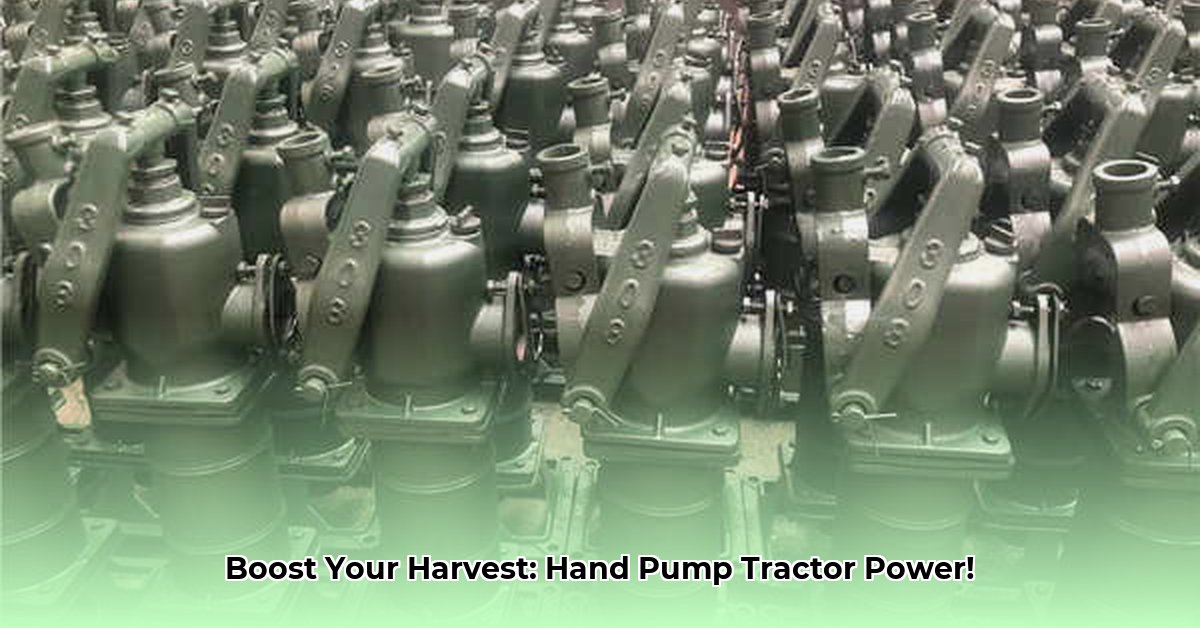
Hand Pump Tractor Supply: Optimizing Water Use in Sustainable Agriculture
Water scarcity is a growing global challenge, particularly impacting agricultural practices. Efficient irrigation is no longer a luxury but a necessity for sustainable food production. Hand pumps, coupled with smart irrigation techniques, offer a powerful solution for farmers seeking to maximize crop yields while minimizing water waste. This article provides a comprehensive guide to selecting, installing, and maintaining hand pumps for optimal water management in sustainable farming. For additional sustainable farming solutions, check out this resource.
The Critical Role of Efficient Irrigation
Water is the lifeblood of agriculture. However, inefficient irrigation practices lead to significant water loss through evaporation and runoff, harming both farm profitability and environmental sustainability. According to the Food and Agriculture Organization of the United Nations (FAO), inefficient irrigation accounts for a substantial portion of global water depletion. This highlights the urgent need for farmers to adopt water-wise approaches.
Why Hand Pumps?
Hand pumps offer a compelling solution for many farming contexts, particularly in areas with limited access to electricity or fuel. They are often more affordable than motorized pumps, requiring less maintenance and contributing to lower operational costs. However, selecting the appropriate hand pump necessitates careful consideration of several key factors.
Selecting the Right Hand Pump: A Practical Guide
Choosing the right hand pump is paramount to efficient water management. The following factors significantly impact your choice:
Water Source Depth: The depth of your well or water source directly influences the type of hand pump required. Shallow wells may be suitable for simple lift pumps, while deeper sources necessitate more powerful pumps, possibly combined with a system of pipes and storage tanks.
Water Demand: The amount of water your crops need depends on factors like crop type, climate, and soil conditions. Accurate assessment of this demand ensures you select a pump with sufficient capacity. Overestimating needs leads to unnecessary costs and potential pump strain. Underestimating demands compromises crop yield.
Terrain and Accessibility: The land's topography impacts the pump's placement and the infrastructure required for water distribution. Hilly terrain may necessitate additional piping and pressure systems. Consider accessibility during installation, maintenance, and potential repairs.
Budget: Hand pumps vary widely in price, reflecting their construction quality and functionality. Balance initial investment with long-term operational costs and maintenance needs. A more expensive, durable pump might prove more cost-effective long-term.
Optimizing Water Delivery: Irrigation Techniques for Sustainable Farming
The efficiency of hand pumps extends beyond the pump itself. Effective irrigation techniques are crucial for minimizing water waste and maximizing crop growth.
Drip Irrigation: Delivers water directly to the roots, minimizing evaporation and runoff. This method is particularly efficient for water-sensitive crops and promotes targeted nutrient delivery. Drip irrigation often yields higher crop yields with a substantially decreased water footprint.
Sprinkler Irrigation: Suitable for larger areas, but may experience higher evaporation rates compared to drip irrigation. Choose sprinkler systems with low-pressure nozzles to minimize water loss. The suitability of sprinkler systems depends on wind conditions and land topography.
Flood Irrigation: While simpler, this method tends to waste significant amounts of water due to evaporation and runoff. It's usually less efficient and should be considered only for very specific situations.
Choosing the most appropriate irrigation method depends on your specific crops, land characteristics, and budget.
Beyond the Pump: Integrated Strategies for Water Conservation
Efficient water use extends beyond the pump and irrigation system. Sustainable farming practices play a significant role in reducing water consumption.
Soil Health: Healthy soil with high organic matter content is more efficient at retaining moisture. Practices like crop rotation, cover cropping, and composting build healthy soils, reducing water requirements. "Healthy soil is the cornerstone of water efficiency in agriculture," states Dr. Emily Carter, Soil Scientist at the University of California, Berkeley.
Drought-Resistant Crops: Selecting drought-tolerant crop varieties minimizes water stress and reduces the overall water demand of the farm. Careful crop selection is a critical component of sustainable water management.
Mulching: Applying mulch to the soil surface reduces evaporation, keeping the soil moist for longer periods. Mulching helps maintain soil moisture and improves soil micro-climate.
These integrated approaches significantly enhance water-use efficiency.
A Step-by-Step Guide to Implementing Sustainable Irrigation
Assess Your Water Needs: Carefully evaluate your water resources and the water requirements of your crops. This initial assessment guides your pump selection and irrigation design.
Select the Appropriate Hand Pump: Choose a pump suitable for your water source, water demand, and budget. Thoroughly consider the factors discussed previously.
Design Your Irrigation System: Plan the layout of your irrigation system, considering the pump location, piping, and distribution method (drip, sprinkler, etc.). A well-designed system minimizes water loss and maximizes efficiency.
Install and Maintain: Install and maintain your system properly. Regular maintenance, including leak checks and cleaning, ensures optimal performance and extends the lifespan of your equipment. "Preventive maintenance is key for long-term performance and cost savings," advises Mr. John Smith, Agricultural Engineer at the International Water Management Institute.
Implementing these steps allows farmers to efficiently utilize water, boosting crop yields and contributing to a more sustainable agricultural system. Continuous learning and adopting new technologies will further refine water-use practices, securing a future of sustainable food production.